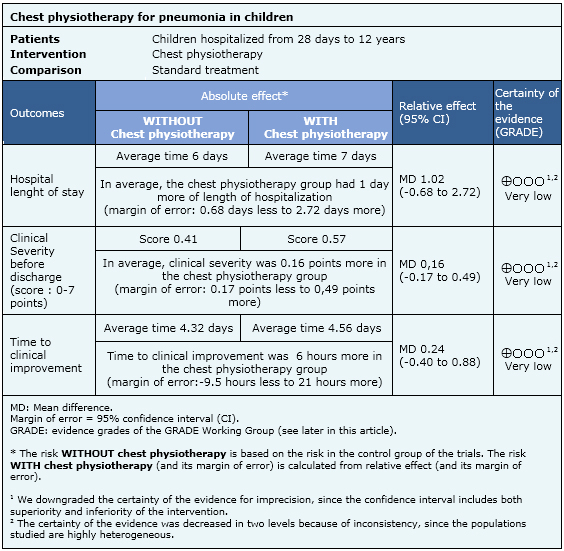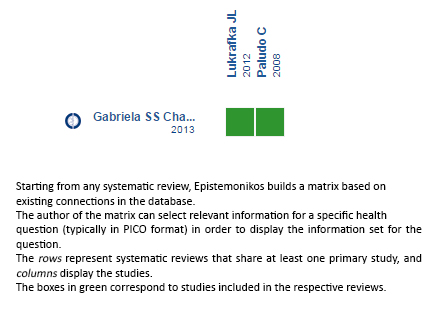Epistemonikos summaries
← vista completaPublished on October 20, 2015 | http://doi.org/10.5867/medwave.2015.6287
What is the effect of chest physiotherapy in hospitalized children with pneumonia?
¿Cuál es el efecto de la kinesioterapia respiratoria en niños hospitalizados por neumonía?
Abstract
Chest physiotherapy is applied in clinical practice for the treatment of pneumonia. However, its use is still controversial. Searching in Epistemonikos database, which is maintained by screening 30 databases, we identified one systematic review including two relevant randomized controlled trials. We combined the evidence using meta-analysis and generated a summary of findings table following the GRADE approach. We concluded it is unclear whether chest physiotherapy increases or decreases the length of hospitalization, severity, or the time to clinical improvement in children with pneumonia because the certainty of the evidence is very low.
Problem
Pneumonia is an acute inflammatory lung disease, affecting people at different ages worldwide. However, the most severe consequences and morbidity are related to young children and elderly subjects. Chest physiotherapy has been widely used for pediatric patients. The main goal of this therapy is to assist the clearance of bronchial secretions, maintain lung capacities and to improve clinical outcomes reducing airway resistance and work of breathing.
Methods
We used Epistemonikos database, which is maintained by screening more than 30 databases, to identify systematic reviews and their included primary studies. With this information, we generated a structured summary using a pre-established format, which includes key messages, a summary of the body of evidence (presented as an evidence matrix in Epistemonikos), meta-analysis of the total of studies, a summary of findings table following the GRADE approach and a table of other considerations for decision-making.
|
Key messages
|
About the body of evidence for this question
|
What is the evidence. |
We found only one systematic review [1] including two pertinent randomized controlled trials [2],[3]. |
|
What types of patients were included |
The studies included hospitalized patients with pneumonia that were clinically stable for receiving chest physiotherapy. Both baseline risk and pneumonia severity of patients were variable. Age ranged from 29 days to 12 years. |
|
What types of interventions were included |
Different types of chest physiotherapy were used. The first study applied standardized chest physiotherapy including positioning, thoracic vibration, thoracic compression, positive expiratory pressure, breathing exercises and forced exhalation with the glottis open or ’huffing’ [2]. The other study made postural drainage, thoracic squeezing, chest percussion, vibration, cough stimulation and secretions suctioning (if necessary)[3]. Frequency and duration of chest physiotherapy were variable. In the first study patients received it three times daily [2] and in the other study patients received it twice daily for 30 minutes each session [3]. All studies were compared with standard treatment (oxygen administration, antibiotics and fluids if necessary). |
|
What types of outcomes |
Time to clinical resolution, hospital length of stay, arterial oxygen saturation, X-ray, lung auscultation, and cough duration. |
Summary of findings
The information on the effects of chest physiotherapy is based on two randomized trials including 177 patients. Both studies included hospital length of stay as an outcome. One study measured clinical severity [2] and one study considered time to clinical improvement [3].
- It is unclear whether chest physiotherapy increases or decreases hospital length of stay in children with pneumonia because the certainty of the evidence is very low.
- It is unclear whether chest physiotherapy increases or decreases the clinical severity of pneumonia in children with pneumonia because the certainty of the evidence is very low.
- It is unclear whether chest physiotherapy increases or decreases the time to clinical improvement in children with pneumonia because the certainty of the evidence is very low.


Other considerations for decision-making
|
To whom this evidence does and does not apply |
|
| About the outcomes included in this summary |
|
| Balance between benefits and risks, and certainty of the evidence |
|
| What would patients and their doctors think about this intervention |
|
| Resource considerations |
|
| Feasibility and implementation |
|
|
Differences between this summary and other sources |
|
| Could this evidence change in the future? |
|
How we conducted this summary
Using automated and collaborative means, we compiled all the relevant evidence for the question of interest and we present it as a matrix of evidence.

Follow the link to access the interactive version: Chest physiotheraphy in hospitalized children with pneumonia
Notes
The upper portion of the matrix of evidence will display a warning of “new evidence” if new systematic reviews are published after the publication of this summary. Even though the project considers the periodical update of these summaries, users are invited to comment in Medwave or to contact the authors through email if they find new evidence and the summary should be updated earlier. After creating an account in Epistemonikos, users will be able to save the matrixes and to receive automated notifications any time new evidence potentially relevant for the question appears.
The details about the methods used to produce these summaries are described here http://dx.doi.org/10.5867/medwave.2014.06.5997.
Epistemonikos foundation is a non-for-profit organization aiming to bring information closer to health decision-makers with technology. Its main development is Epistemonikos database (www.epistemonikos.org).
These summaries follow a rigorous process of internal peer review.
Conflicts of interest
The authors do not have relevant interests to declare.

